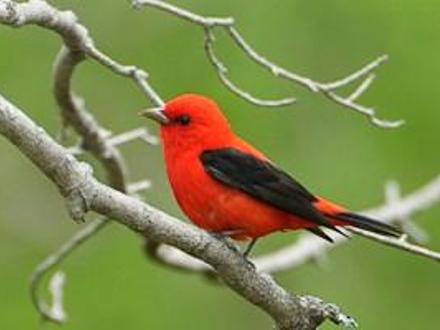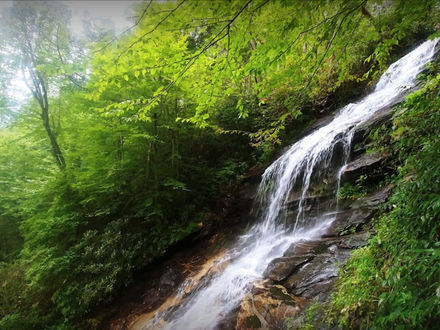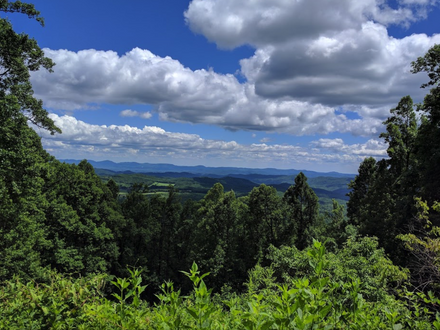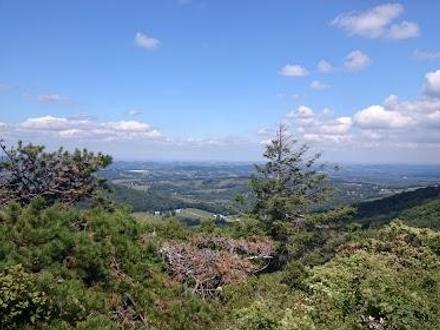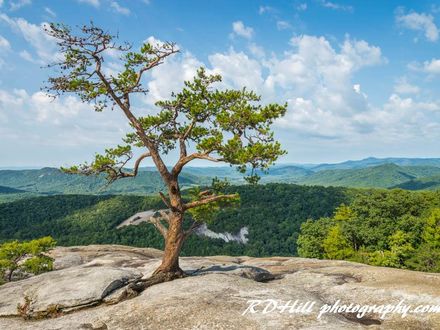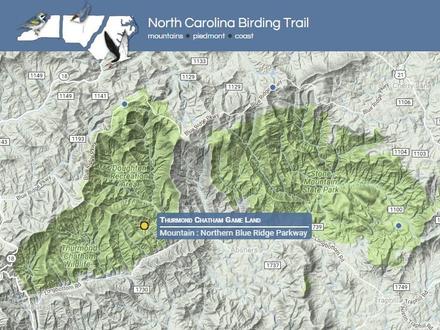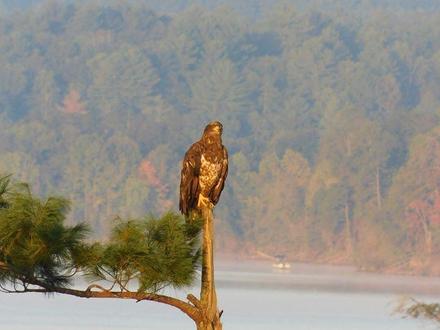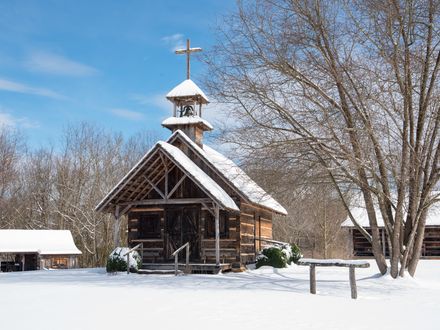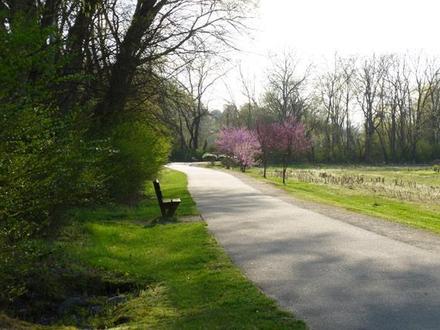Check box to save to My Trip
- Outdoor Activities
- 336-372-8568
Doughton Park is a spectacular park located right on the edge of the Blue Ridge Escarpment. Visitors to the park have several hiking options and may choose to focus on mid-elevation species along the upper rim of the escarpment, or take a more strenuous approach to the base of the escarpment. For a good sampling of the upper edge of the escarpment, the Fodder Stack Trail provides a quick way to see Wild Turkey, Red-eyed and Blue-headed Vireos, Ovenbird, Chestnut-sided, Hooded, Black-throated Green and Black-and-white Warblers, Scarlet Tanager and many other woodland and shrubby field species. For a longer look at many of these species and others, hike the entire Bluff Mountain Trail. Grasshopper Sparrow and Horned Lark are often seen in the agricultural lands near the Parkway and close to the Bluffs Lodge. For the more adventurous, a hike to the bottom on the Grassy Gap Fire Road or Cedar Ridge Trail provide possible looks at mid- to low-elevation species like Acadian Flycatcher, Swainson’s Warbler and Worm-eating Warbler. These lower sections may also be reached via Longbottom Road, off NC 18. The diversity of habitats, size of the park, and its amenities can provide many days of exploration and birding. Species of Interest: Blue-headed Vireo, Black-white Warbler, Swainson’s Warbler, American Redstart, Ovenbird, Hooded Warbler Habitats: northern hardwood/cove forest, oak forest & mixed hardwoods/pine, early successional, river/stream/wetland. Special Concerns: Sections of the Blue Ridge Parkway are often closed during the winter months due to snow and ice. Other temporary closures may occur following storms as a result of hazardous road conditions. It is best to call ahead to get current road conditions (828-298-0398). The use of tapes to attract birds is prohibited.
- Outdoor Activities
- Purlear
E.B. Jeffress Park is named for the man who successfully persuaded the federal government to position the Blue Ridge Parkway on its present location. The Cascades parking area, restroom and picnic area are at Milepost 271.9. The 1.2 mile Cascade Trail begins at the restroom and forms a loop that goes down to a viewing overlook above the cascades on Fall Creek. This trail runs through an oak forest along the ridge and enters into a cove hardwood forest near the creek. The 0.5 mile Tompkins Knob Trail begins at the far (south) end of the parking area and passes through mixed hardwood forest to the Tompkins Knob parking area (Milepost 272.5) and the Jesse Brown Cabin and Cool Springs Baptist Church. Jeffress Park offers nice opportunities to see migrating birds in spring and summer residents, including Eastern Wood-Pewee, Hooded, Canada, Black-throated Blue and Black-throated Green Warblers, Eastern Towhee, Wood Thrush, White-breasted Nuthatch and Dark-eyed Junco. Species of Interest: Wood Thrush, American Redstart, Ovenbird, Hooded Warbler, Black and White Warbler, Scarlet Tanager Habitats: oak forest & mixed hardwoods/pine, river/stream. Special Concerns: Sections of the Blue Ridge Parkway are often closed during the winter months due to snow and ice. Other temporary closures may occur following storms as a result of hazardous road conditions. It is best to call ahead to get current road conditions. The use of tapes to attract birds is prohibited. This site can be very busy on summer weekends; it’s best to visit early before crowds arrive.
- Outdoor Activities
- Blue Ridge Parkway Milepost 270.5
- 828-298-0398
The Lewis Fork Overlook provides beautiful panoramic views east from the Blue Ridge Parkway to the Yadkin River valley. Cerulean Warblers are a highlight for this site and are usually found during spring at Milepost 270.5, a short 0.3 mile walk south on the Parkway from the Overlook. Many warbler species, including Black-throated Blue, Black-throated Green, Black and White Warblers, Ovenbird and American Redstart breed at this site and still others can be found during migration. Also be on the lookout for Pileated and Downy Woodpeckers, Eastern Phoebe, Wood Thrush, Blue-headed and Red-eyed Vireos, Scarlet Tanager and White-breasted Nuthatch. Species of Interest: White-breasted Nuthatch, Wood Thrush, Cerulean Warbler, Black-throated Blue Warbler, Black-throated Green Warbler, Scarlet Tanager Habitats: northern hardwood/cove forest Special Concerns: Sections of the Blue Ridge Parkway are often closed during the winter months due to snow and ice. Other temporary closures may occur following storms as a result of hazardous road conditions. It is best to call ahead to get current road conditions (828-298-0398). The use of tapes to attract birds is prohibited.
- Outdoor Activities
- 39273 Blue Ridge Pkwy, Sparta
This area is best known as a spot to monitor the spring and, especially, fall migration of raptors through the southern Appalachians, as a regularly monitored hawk migration station since the 1970's. From mid-August through November, the site is usually staffed by knowledgeable volunteers and boasts high numbers of migrating raptors. Early migrating Osprey, Bald Eagle, Peregrine Falcon, Merlin, and others keep watchers entertained. Mid- to late-September can bring thousands of Broad-winged Hawk. Later in the season, Golden Eagles peak in number, along with Sharp-shinned, Cooper's and Red-shouldered Hawks. Migrating songbird movements at the site can also be impressive, with numerous warblers, tanagers, and grosbeaks winging their way past the gap. Red-headed Woodpecker often show up in September, when large flights of Monarch butterflies and dragonflies often occur, as well. The site is small, but it sits on the edge of the Blue Ridge Escarpment and so hosts some interesting breeding species, including Black-throated Green Warbler, Chestnut-sided Warbler, Ovenbird, and Cedar Waxwing. This site is just north of Doughton Park, which has amenities including restrooms, picnic facilities and camping from about May 15 through November 1.
- Outdoor Activities
- 3042 Frank Parkway, Roaring Gap
- 336-957-8185
Stone Mountain State Park consists of over 15,000 acres. The park is bordered to the north by the Blue Ridge Parkway, and by Thurmond Chatham Game Land to the west. Elevations in the park range from 1,900 feet to around 3,500 feet. The park’s main feature is a 600 foot granite dome and approximately 17 miles of designated trout waters. Along these trout waters you might see a Belted Kingfisher or hear the song of a Louisiana Waterthrush. Forests dominated by chestnut oak cover the slopes of the park's rock-faces, while scarlet and black oaks, red maple, hickory, white pine and dogwood populate the woodlands. The understory is made up of blueberry, rhododendron and mountain laurel. Small, slow-growing pines and cedar fringe the rock, while mats of lichens, mosses and small ferns grow on areas of open, exposed granite. Along the Stone Mountain Loop Trail you will pass through these different community types. A variety of woodpeckers inhabit the area, including Red-bellied and Downy Woodpeckers, and Northern Flicker. Also be on the lookout for Scarlet Tanager, Whip-poor-will, Ruffed Grouse and Wild Turkey. Species of Interest: Ruffed Grouse, Wild Turkey, Whip-poor-will, Scarlet Tanager Habitats: oak forest & mixed hardwoods/pine, rocky outcrop, river/stream.
- Outdoor Activities
- 919-707-0050
Thurmond Chatham Game Land is adjacent to the Blue Ridge Parkway and Doughton Park. Habitat management on the Game Land, including prescribed burning, timber harvest and thinning, mowing, and food plot management, supports a variety of forest and scrub bird species, including Red-eyed and Blue-headed Vireos, Indigo Bunting, Scarlet Tanager and Eastern Wood-Pewee. From Long Bottom Road, walk up Bell Branch Road for 0.6 miles to some small fields. At 1.1 miles, a wet, brushy area attracts a variety of birds, including numerous wood warblers, thrushes and vireos. A full 2 miles up the road are some larger area attracts a variety of birds, including numerous wood warblers, thrushes and vireos. A full 2 miles up the road are some larger fields. During the spring migration, watch and listen for Swainson’s Thrush. Species of Interest: Acadian Flycatcher, Black-throated Green Warbler, Hooded Warbler, Ovenbird, Louisiana Waterthrush Habitats: oak forest & mixed hardwoods/pine, dry coniferous woodlands, early successional, river/stream Special Concerns: Hunting is allowed on Thurmond Chatham Game Land during certain times of the year. Birders should be aware of current hunting regulations and seasons, and take adequate safety precautions during those times.
- Outdoor Activities
- 499 Reservoir Rd, Wilkesboro
- 336-921-3390
This US Army Corps of Engineers Reservoir affords many birding opportunities. A birding trip here should start at the Visitor Assistance Center. Trails that pass through a variety of habitats afford great views of the reservoir. Watch the margins of the lake for migrant shorebirds, including Spotted and Solitary Sandpipers. During the breeding season, many birds of the transition zone from piedmont to mountain habitats are found here, including Pine and Yellow-throated Warblers and good numbers of Yellow-billed Cuckoo. The pine-dominated areas around the lake are some of the most reliable areas for Brown-headed Nuthatch closest to the higher mountain regions. Evenings under a full moon bring Whippoorwill calling. In winter, the lake attracts a number of gull species, including many Ring- billed Gulls, as well as rarer species for the mountains, such as Herring and Bonaparte’s Gulls. In November and March, various waterfowl species turn up with regularity. Some of the grassy and shrubby areas at the various parks attract migrating and wintering sparrows like White-crowned, Swamp and Vesper Sparrows. Species of Interest: Spotted Sandpiper, Solitary Sandpiper, Whippoorwill, Yellow-billed Cuckoo, Brown- headed Nuthatch, wintering waterfowl. Habitats: floodplain forest, oak forest & mixed hardwoods/pine, wetlands, early successional, reservoir Special Concerns: Hunting is allowed on W. Kerr Scott Reservoir during certain times of the year. Birders should be aware of current hunting regulations and seasons, and take adequate safety precautions during those times.
- Outdoor Activities
- 11928 NC 268, West Ferguson
- 336-973-3237
This small and historic property contains a collection of log buildings where programming focuses on the historical and cultural heritage of the area, but good birding opportunities exist, as well. Ample agricultural lands provide nesting areas for Eastern Meadowlark, Blue Grosbeak, Field, Song and Chipping Sparrows, and other open habitat birds. Shrubby habitats support White-eyed Vireo, Eastern Towhee, Gray Catbird and Brown Thrasher. A pleasant walk down a trail to the Yadkin River should yield breeding Northern Parula, Yellow-throated Warbler, Common Yellowthroat, Yellow-throated Vireo, Yellow-billed Cuckoo, Summer Tanager, and Baltimore and Orchard Orioles. Migration seasons bring good numbers of tanagers and warblers following the river, as well as sparrows and other songbirds to the agricultural fields. During the fall, this area is also a good place to watch for migrating raptors, given its position at the bottom of the Blue Ridge Escarpment. Almost any time of year, a visitor can easily see quite a few common birds, including Northern Cardinal, Northern Mockingbird, Carolina Wren, Carolina Chickadee, and several woodpeckers. Species of Interest: Yellow-billed Cuckoo, Northern Parula, Yellow-throated Warbler, Blue Grosbeak, Eastern Meadowlark Habitats: northern hardwood/cove forest, dry coniferous woodlands, oak forest & mixed hardwoods/pine, river/stream Please call ahead to avoid conflicts with school groups or special events.
- Outdoor Activities
- 336-651-8967
This paved greenway system is a nice mix of riparian zone and other habitats. The YMCA- Riverside Park section adjoins large recreational fields, which attract good numbers of migrating shorebirds and songbirds. The Reddies River-Health Foundation section is adjacent to large agricultural fields with ample shrubby borders and fruit-producing trees and shrubs. Both sections also border good sized patches of mature forest. This variety of habitats reflects the variety of bird species found at any season. Summer brings Indigo Bunting, occasional Blue Grosbeak, Orchard Oriole, a variety of vireos, Yellow-billed Cuckoo, and many warblers, including Yellow-throated Warbler, Common Yellowthroat and Northern Parula. Cliff and Barn Swallows are also found along the Greenway. Fall can be very good time to visit, with a wide variety of resident and more common birds (e.g., Gray Catbird, Northern Cardinal, woodpecker species) and many migrating songbirds and shorebirds. Recently, Upland Sandpiper and Buff-breasted Sandpiper have been observed in the recreational fields by the YMCA access, along with scores of Killdeer and Canada Geese. During the fall migration, the Reddies River section hosts good numbers of warblers, including Tennessee, Magnolia, Black-throated Green, Cape May, Black-throated Blue Warblers and Ovenbird. Species of Interest: Yellow-billed Cuckoo, Yellow-throated Vireo, Northern Parula, Baltimore Oriole. Habitats: floodplain forest, oak forest & mixed hardwoods/pine, river, early successional The greenway has seven trailheads between North Wilkesboro and W. Kerr Scott Reservoir. In North Wilkesboro: 1) Smoot Park, 2) on D Street at Reddies River Bridge, 3) on D Street at the Health Foundation/West Park. In Wilkesboro: 1) at Cornerstone Church, 2) at Tyson Trailhead behind Wilkes Heritage Museum, 3) at the east end of Collegiate Avenue, 4) behind Wilkes Family YMCA adjacent to Rivers Edge Park. The final trailhead is at the base of the dam at W. Kerr Scott Reservoir. Parking is available at all trailheads. The greenway can be accessed daily during daylight hours.
- Outdoor Activities, Farms and Orchards
- 2812 Clingman Road, Ronda
- 336-951-7661


